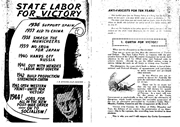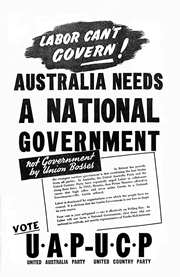

JCPML. Records of Morris Hughes. State Labor for Victory. 1943 Federal Election pamphlet, NSW State Labor Party. JCPML00278/2

'Labor Can't Govern! Australia needs a National Government' United Australia Party-United Country Party election advertisement, 1943.
The Bulletin, 28 July 1943
View ALP election film footage from 1943 featuring Prime Minister Curtin.
JCPML. Records of the Australian Labor Party WA Branch. Man of the Hour, 1943. JCPML00166/1/1.
(Courtesy Australian Labor Party, WA Branch)
Labor entered the campaign with only 36 of the 74 members of the House of Representatives and in a narrow minority in the Senate. Despite continually favourable poll ratings there was still anxiety in Labor ranks about the likely outcome, not the least being a concern that Curtin after his narrow squeak in 1940 might again have a struggle to retain his own seat: for this reason perhaps he spent the entire last week of the campaign in Perth. On the Opposition side the divisions in their own ranks, clearly in evidence since veteran Billy Hughes became UAP parliamentary leader in the wake of Menzies’ resignation as prime minister, had deepened over how to respond to Curtin’s introduction of a measure of conscription. At a party meeting in March 1943 (the first in over a year) Menzies’ allies did not move at that stage for a spill of leadership positions, 16 of their members joined with Menzies on 31 March in forming the so-called national Service group, formed ‘for the purpose of gingering up the Opposition’. 59
For the first time Labor’s campaign was launched—on 25 July—from a broadcasting studio in Canberra, a move designed to emphasise Curtin’s ‘position as a national leader’. 60 His policy speech emphasized wartime leadership and the need for ‘balance’ in the forms of contribution Australian could make to the ongoing war effort. David Day has suggested 61 that in his criticism of his predecessors Curtin was ‘implicitly’ repeating Ward’s charges to the point where he suggested that ‘You cannot risk a government from the U.A.P. and the Country Party which would make the same terrible mistake it made before Japan came into the war’. 62 Elsewhere in the speech he stressed Australia’s ‘membership of the British Commonwealth, and our loyalty to the throne’ before concluding that his government’s policy was ‘victory in war, victory for the peace’. 63
View the ALP policy speech by John Curtin, 26 July 1943.
Three days earlier Opposition Leader Fadden had delivered the Opposition policy speech in Brisbane and there was immediate evidence of clear disunity when Menzies on the following night attacked Fadden’s proposal for one-third of war time taxation to be returned to taxpayers in instalments after the war. Fadden for his part described ‘this stab in the back’ as ‘another in betrayal in the series for which Mr Menzies has become notorious’ and he went on to suggest that Menzies was placing his own personal ambition ahead of the Opposition’s election campaign. 64 In addition to some other specific promises and a continuing call for a national government, Fadden focussed on charges that ‘the Government’s emergency war powers were being used to effect socialism and that the communists were a sinister force behind Labor’. 65 Indeed, on one occasion he asserted that if elected he would seek to ban the Communist Party, a point on which he was in agreement with Menzies.
Curtin for his part campaigned even more vigorously than in either of this two previous elections as leader to the extent that to buy time towards the end of the campaign he flew in a Lancaster bomber from Adelaide to Perth in what was only the second air trip of his life. By 11 August, the tenor of his speeches had been modified to the extent, in David Day’s opinion, that ‘the party leader had given way to the national leader’ as when he acknowledged that ‘the previous Government had done a good deal before his government had taken over’ 66 and three days before the election he insisted publicly that his party would not use the war to socialize any industry (see below). It was perhaps hardly surprising in the circumstances that the ALP was prepared to produce electoral posters suggesting that ‘if you want to vote for Curtin then you need to vote Labor’. Curtin also showed his willingness to tackle internal problems head on when he quickly bought Evatt into line after the latter had issued a statement that he would be prepared to join a national government if Labor lost. 67
In terms of the press there were critics and the Packer and Murdoch press were particularly hostile. Murdoch himself wrote that Menzies was able to give ‘ expression and strength to the doctrines of the life of a large percentage of the people . . . and on occasions is the best exponent of the thoughts of all. 68 For several months previously Murdoch had been attacking Curtin and his government. Thus, on 24 May he suggested that the Government ‘inexperience of war, travel, and of foreign affairs, have involved us abroad in deep injuries’ and he condemned Curtin’s refusal ‘to divert forces here for great offensives” in a broadcast probably penned by him suggesting that Curtin was /a narrow parochial man’. 69 On the other side of the ledger for the first time Labor was supported by the Sydney Morning Herald referring to him as ‘Australia’s leader’. In retrospect, one suspects the result should never have been in doubt.